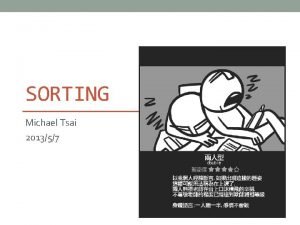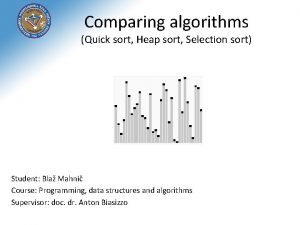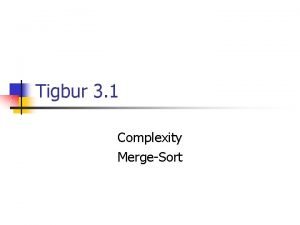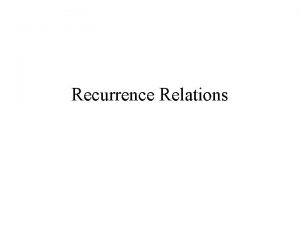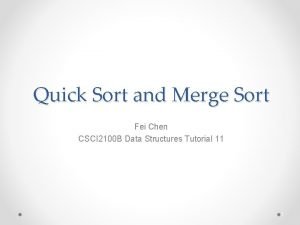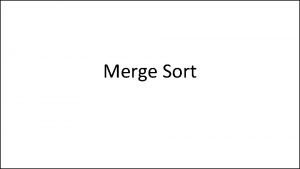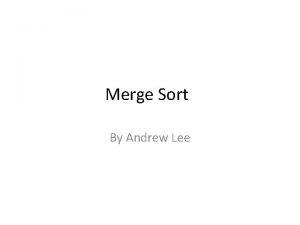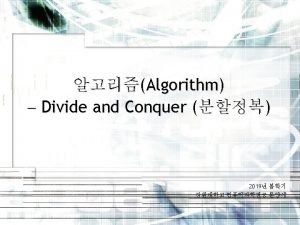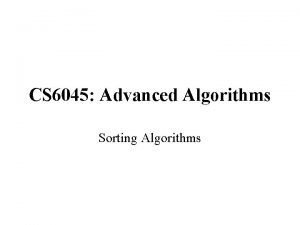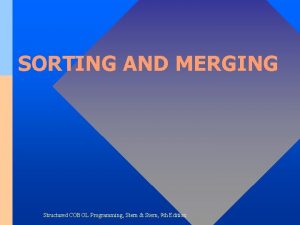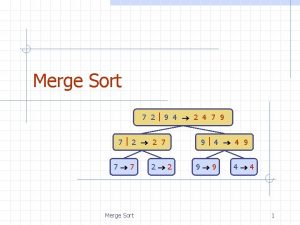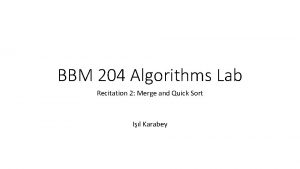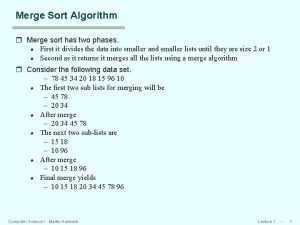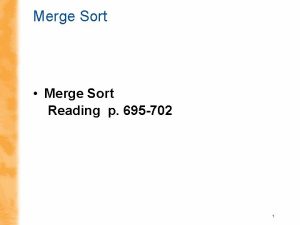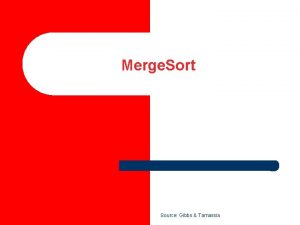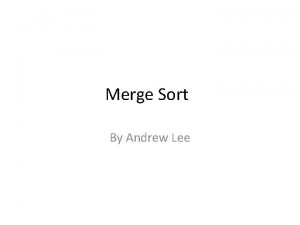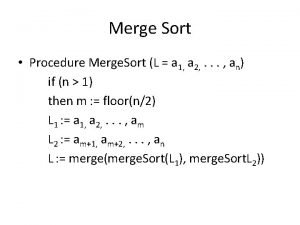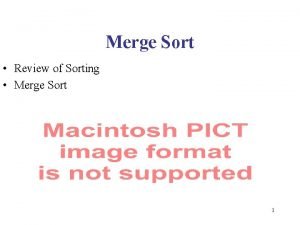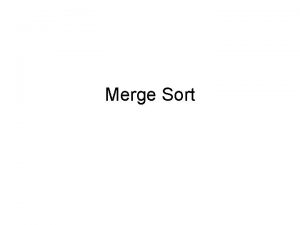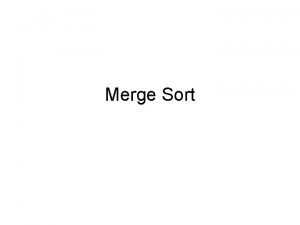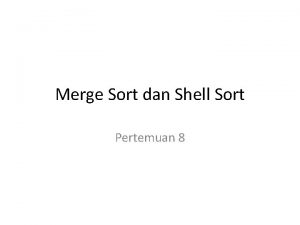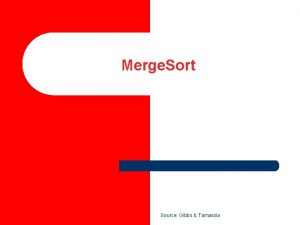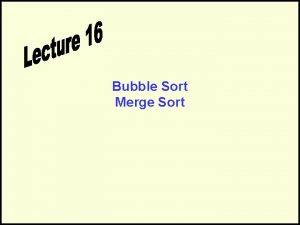Data Structure Algorithm Lecture 4 Merge Sort Divide








![Mergesort(A[1, n]) ) Merge( Merge. Sort(A[1, n/2]), Merge. Sort(A[n/2+1, n]) 9 Mergesort(A[1, n]) ) Merge( Merge. Sort(A[1, n/2]), Merge. Sort(A[n/2+1, n]) 9](https://slidetodoc.com/presentation_image_h/05eea219e1fba415897a67c67e6a2784/image-9.jpg)



![merge(item_type s[], int low, int middle, int high) { int i; /* counter */ merge(item_type s[], int low, int middle, int high) { int i; /* counter */](https://slidetodoc.com/presentation_image_h/05eea219e1fba415897a67c67e6a2784/image-13.jpg)



- Slides: 16

Data Structure & Algorithm Lecture 4 – Merge Sort & Divide and Conquer JJCAO

Recitation - Asymptotic Notations 2

Recitation - Example 3

The Sorting Problem • 4

Sorting - The Data • In practice, we usually sort records with keys and satellite data (non-key data) • Sometimes, if the records are large, we sort pointers to the records • For now, we ignore satellite data assume that we are dealing only with keys only i. e. focus on sorting algorithms 5

Divide and Conquer • Divide – the problem into several (disjoint) subproblems • Conquer – the sub-problems by solving them recursively • Combine – the solutions to the sub-problems into a solution for the original problem 6

Divide and Conquer 7

Merge Sort • Divide: Split the list into 2 equal sized sub-lists • Conquer: Recursively sort each of these sub-lists • Combine: Merge the two sorted sub-lists to make a single sorted list 8
![MergesortA1 n Merge Merge SortA1 n2 Merge SortAn21 n 9 Mergesort(A[1, n]) ) Merge( Merge. Sort(A[1, n/2]), Merge. Sort(A[n/2+1, n]) 9](https://slidetodoc.com/presentation_image_h/05eea219e1fba415897a67c67e6a2784/image-9.jpg)
Mergesort(A[1, n]) ) Merge( Merge. Sort(A[1, n/2]), Merge. Sort(A[n/2+1, n]) 9

10

Pseudo Code 11

Merge(A, p, q, r) p<=q < r 1. Point to the beginning of each sub-array 2. choose the smallest of the two elements 3. move it to merged array 4. and advance the appropriate pointer Running Time: cm for some constant c > 0 & m = r-p+1 12
![mergeitemtype s int low int middle int high int i counter merge(item_type s[], int low, int middle, int high) { int i; /* counter */](https://slidetodoc.com/presentation_image_h/05eea219e1fba415897a67c67e6a2784/image-13.jpg)
merge(item_type s[], int low, int middle, int high) { int i; /* counter */ queue buffer 1, buffer 2; /* buffers to hold elements for merging */ init_queue(&buffer 1); init_queue(&buffer 2); for (i=low; i<=middle; i++) enqueue(&buffer 1, s[i]); for (i=middle+1; i<=high; i++) enqueue(&buffer 2, s[i]); i = low; while (!(empty_queue(&buffer 1) || empty_queue(&buffer 2))) { if (headq(&buffer 1) <= headq(&buffer 2)) s[i++] = dequeue(&buffer 1); else s[i++] = dequeue(&buffer 2); } } while (!empty_queue(&buffer 1)) s[i++] = dequeue(&buffer 1); while (!empty_queue(&buffer 2)) s[i++] = dequeue(&buffer 2); 13

Running Time • • Divide: lgn Conquer: 0 Combine: n O(n log n) time in the worst case 14

Properties of Sorting Algorithms • Not In place – a constant number of elements of the input array are ever stored outside the array • Comparison based – the only operation we can perform on keys is to compare two keys – A non-comparison based sorting algorithm • looks at values of individual elements • requires some prior knowledge • Stable – elements with the same key keep their order 15

Homework 3 • Template Dynamic Array & Bubble Sort • Deadline: 22: 00, Sep. ? , 2011 16
 Quick sort merge sort
Quick sort merge sort Quick sort merge sort
Quick sort merge sort Who invented selection sort
Who invented selection sort What is the recurrence relation for merge sort :
What is the recurrence relation for merge sort : Recurrence relation
Recurrence relation Quicksort vs merge sort
Quicksort vs merge sort Merge sort complexity
Merge sort complexity Bottom up merge sort
Bottom up merge sort Binary merge sort
Binary merge sort Merge list
Merge list Why is merge sort n log n
Why is merge sort n log n Mips merge sort
Mips merge sort Merge sort medium
Merge sort medium Sort and merge in cobol
Sort and merge in cobol Loop invariant of merge sort
Loop invariant of merge sort Merge sort decision tree
Merge sort decision tree Merge sort pseudocode
Merge sort pseudocode
